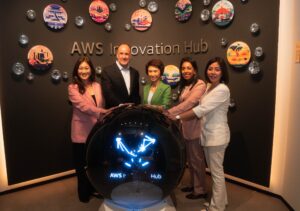
For someone from a technology outfit dealing with deep research, Jan Adriaenssens does not shy away from repeating a lesson learnt from early rollouts of smart cities in Europe.
The technology is important, he says, but making a city smart is not just about deploying fancy technology but ultimately solving urban problems that citizens face.
The director for City of Things at Belgium-based research hub imec has seen the importance of having citizens onboard to make a smart city work. Though they may not understand how the technology works, they will participate in a smart city programme as long as they can see the benefits of doing so, he says.
In Antwerp, where imec is running a smart city programme, the technology enables citizens to achieve their common goals, says Adriaenssens, who is speaking at the imec Technology Forum in Singapore next week.
In this month’s Q&A, he tells Techgoondu that becoming a smart city is only a means to an end, not the goal itself.
NOTE: The responses have been edited for brevity and house style.
Q: From the experience in Europe, how much does the average citizen understand about smart city technologies?
A: I think that the more important question actually is “how much do citizens need to understand about smart city technologies?” The aim of smart city innovations is to improve the quality of life in our cities.
Citizens do not necessarily need to know how we create a green wave for cyclists or how we know how much parking space is still available. I passionately advocate that this knowledge and technology is accessible to everyone who wants to know it, but that doesn’t mean that everyone has to know it. What matters is that they notice the positive effect.
Compare it to other big innovations in urban infrastructure that have implemented throughout history, like sewer systems and traffic lights. These inventions have greatly improved our quality of life, yet most of us have never stopped to consider how exactly the sewer system functions or according to which algorithms the traffic lights decide to change. Even without understanding the system, we can enjoy its benefits.
Q: Can you briefly share some of the main learning points from the rollouts of smart city technologies such as in Copenhagen?
A: The first thing to keep in mind is that smart cities are not just cities crammed with sensors and actuators just for the sake of it. A truly smart city sets itself specific goals to improve the quality of life in the city.
They can then use smart city technology – alongside other policy measures and infrastructure improvements – to achieve these goals. For example, in the last 40 years, Copenhagen has aimed to become (and remain) the most bike-friendly city in the world.
The local government does what they need to do to achieve this goal, from constructing new bike lanes to implementing advanced new technology. So becoming a smart city is only a means to an end, not the goal itself.
The second learning point is related to this. To achieve any major societal, environmental or economic goal, you need to involve all potential stakeholders. That’s why the quadruple helix – consisting of industry partners, research institutions, governments and citizens – is an essential aspect of our City of Things programme in Belgium.
Involving every one of these stakeholders is hard and cumbersome at times, but it is a prerequisite for any successful smart city project.
A third learning point concerns the technology itself, more specifically, the promise inherent to the Internet of Things. We have always used technology to enhance city life, from aqueducts in ancient Roman times to traffic lights in the late 19th century, but until now these technological developments were always static, top-down solutions.
They only functioned on one level – a traffic light improves road safety at one specific crossroads – and there was no interaction with citizens.
The Internet of Things, on the other hand, functions on two levels. At a macro level, we can use the data collected to analyze trends and influence city-wide phenomena. For instance, we can track traffic throughout the city and use this data to optimize mobility plans, often even real-time.
But we could also use the same information at a micro level by sharing real-time data with citizens so they can create individualized solutions. For instance, we could let people calculate the fastest route to work by integrating traffic light information into their GPS.
Q: How do you get citizens involved at an early stage?
A: Early involvement implies that you should already get citizens involved in the ideation stage. You need to know how they feel about a given topic before you start developing anything.
By involving end users at an early stage, you can ensure that solutions are tailored to real needs, attitudes, habits and contextual factors. It is only a small additional effort at the start of your project, but it will significantly reduce failure and delays further down the road.
At imec, we already have extensive experience with living lab research. In an early stage, we get citizens involved through one-on-one talks, group sessions, or brainstorming to develop a proof of concept.
In a second stage, we let users experiment with different models and prototypes to further fine-tune the product, service or solution. Within our City of Things programme, we’re taking this experience to a higher level, with larger groups of users (citizens) to co-create, test and validate smart city solutions.
We use two techniques to motivate participants. The most obvious one is offering them concrete incentives, like bonus points or vouchers. A second option is to offer citizens personalised information in return for participation. This works remarkably well.
For instance, if you’re tracking cyclists, you can provide them with personal information on how fast they cycle in comparison to the average citizen or suggest faster, healthier cycling routes. If you’re asking them to co-create a specific product, you could offer them early access to the final product.
Or if they participated in research, you can share your findings with them. This way, participants can see the bigger picture and get the fulfillment of being involved in something bigger.
Q: How do you measure the success of a smart city rollout?
A: An ideal smart city programme starts with concrete goals, that is, societal, economic or governmental challenges that need to be tackled. We can measure the success of a smart city rollout by measuring the degree to which the technology contributes to meeting these challenges.
In other words, a successful smart city is not a city that’s filled to the brim with fancy, new technology, but a city that has managed to overcome the typical challenges of urban life by using innovative smart city technology in a strategic and well-considered way.






